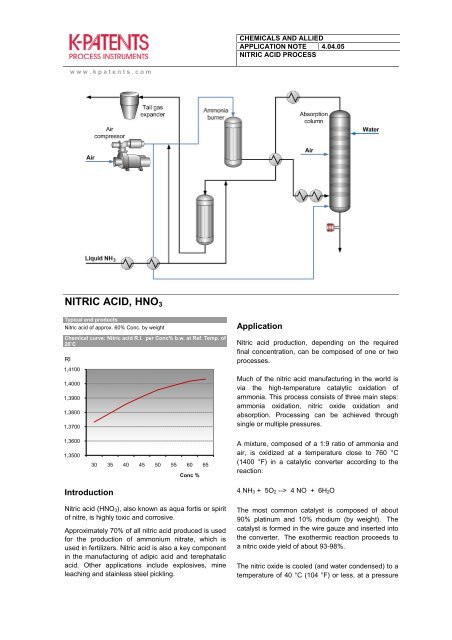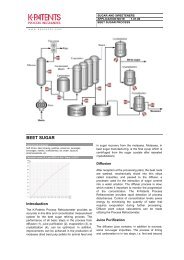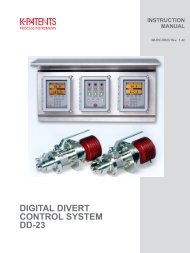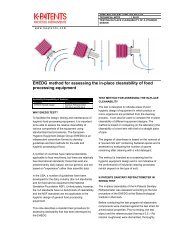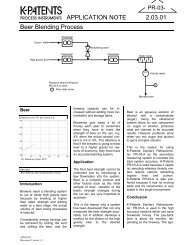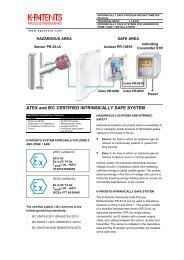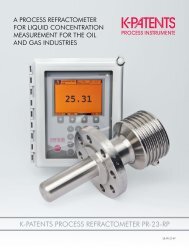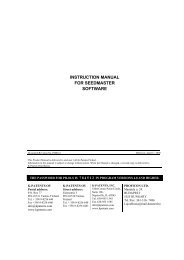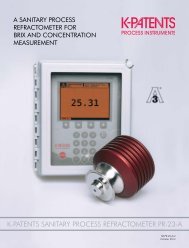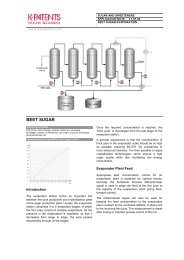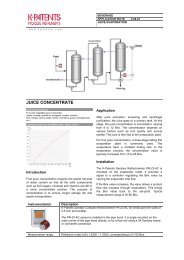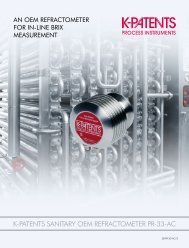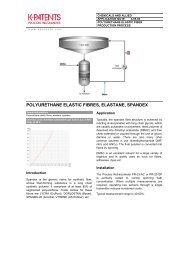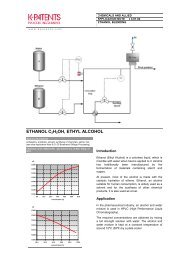Nitric acid (HNO - K-Patents
Nitric acid (HNO - K-Patents
Nitric acid (HNO - K-Patents
Create successful ePaper yourself
Turn your PDF publications into a flip-book with our unique Google optimized e-Paper software.
CHEMICALS AND ALLIEDAPPLICATION NOTE 4.04.05NITRIC ACID PROCESSw w w . k p a t e n t s . c o mNITRIC ACID, <strong>HNO</strong> 3Typical end products<strong>Nitric</strong> <strong>acid</strong> of approx. 60% Conc. by weightChemical curve: <strong>Nitric</strong> <strong>acid</strong> R.I. per Conc% b.w. at Ref. Temp. of20˚CRI1,41001,40001,39001,38001,3700Application<strong>Nitric</strong> <strong>acid</strong> production, depending on the requiredfinal concentration, can be composed of one or twoprocesses.Much of the nitric <strong>acid</strong> manufacturing in the world isvia the high-temperature catalytic oxidation ofammonia. This process consists of three main steps:ammonia oxidation, nitric oxide oxidation andabsorption. Processing can be achieved throughsingle or multiple pressures.1,36001,350030 35 40 45 50 55 60 65Conc %A mixture, composed of a 1:9 ratio of ammonia andair, is oxidized at a temperature close to 760 °C(1400 °F) in a catalytic converter according to thereaction:Introduction<strong>Nitric</strong> <strong>acid</strong> (<strong>HNO</strong> 3), also known as aqua fortis or spiritof nitre, is highly toxic and corrosive.Approximately 70% of all nitric <strong>acid</strong> produced is usedfor the production of ammonium nitrate, which isused in fertilizers. <strong>Nitric</strong> <strong>acid</strong> is also a key componentin the manufacturing of adipic <strong>acid</strong> and terephatalic<strong>acid</strong>. Other applications include explosives, mineleaching and stainless steel pickling.4 NH 3 + 5O 2 --> 4 NO + 6H 2OThe most common catalyst is composed of about90% platinum and 10% rhodium (by weight). Thecatalyst is formed in the wire gauze and inserted intothe converter. The exothermic reaction proceeds toa nitric oxide yield of about 93-98%.The nitric oxide is cooled (and water condensed) to atemperature of 40 °C (104 °F) or less, at a pressure
CHEMICALS AND ALLIEDAPPLICATION NOTE 4.04.05NITRIC ACID PROCESSw w w . k p a t e n t s . c o mupto 7.8 bar (115 psi). The nitric oxide reacts (noncatalytically)with oxygen to form nitrogen dioxideand nitrogen tetroxide via the reaction:2 NO + O 2 --> 2 NO 2 + N 2O 4This reaction is highly dependent on bothtemperature and pressure. Low temperatures andhigh pressures favor the production of nitrogendioxide (preferred) over nitrogen tetroxide.After cooling down, the nitrogen dioxide/nitrogentetroxide mixture enters an absorption column. Thegaseous mixture is introduced to the bottom of thecolumn, while liquid dinitrogen tetroxide and deionizedwater enter from the top. Liquids flowcountercurrent to the gases in the system, while theoxidation takes place between the trays whileabsorptiontakesplace on the trays (usually bubble cap trays). Thereaction in the absorption column proceeds by:3 NO 2 + H 2O --> 2 <strong>HNO</strong> 3 + NOA second air stream entering the column furtheroxidizes the NO and removes the NO 2 from theproduct <strong>acid</strong>. Acid concentrations leaving theabsorption tower are typically between 55-65% byweight.InstallationThe K-<strong>Patents</strong> In-line Refractometer is mounted inthe outlet pipe of the absorber (position 1) to controlthe absorption process and to get a stable nitric <strong>acid</strong>value. The PR-23-M should be installed in a by-pass.When multiple measurements are required,operating two sensors through a single transmitterreduces investment costs.InstrumentationDescriptionTeflon Body Refractometer PR-23-M. A compact refractometer for chemicallyaggressive solutions and ultra-pure fine chemical processes. Connected to theprocess by a G1/2" female or a 1/2" NPT process connection. It has a built-inflow cell designed to keep all metal and other easily corroding parts from cominginto contact with the process liquid.Saunders Body Refractometer PR-23-W. A heavy-duty refractometer forchemically aggressive liquids in large-scale production and in large pipe sizes(diameter 50, 80 or 100mm/2", 3" or 4"). The Saunders body material is graphitecast iron, which provides a solid mechanical base. A PFA-lining ensures thechemical resistance.Measurement range:50-65% <strong>Nitric</strong> <strong>acid</strong>. Typical accuracy +/-0,75% by weight.


